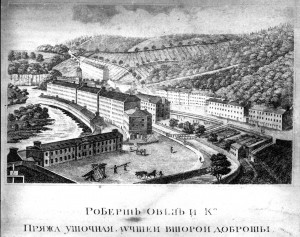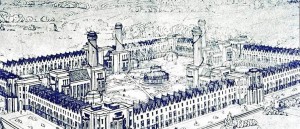- new lanark
In 1799, Owen and his partners acquired the New Lanark Mills from David Dale, while Owen married Dale’s daughter in marriage in 1800.[1] During the next quarter century, Owen made many changes in the New Lanark Mills and created a model of profitability and humane management of the mill and the town around it that became world famous.[2] In New Lanark, Owen tried to change industrial or cultural traditions in favor of his guiding principles that the society and education mold people’s character; individuals do not make themselves; so, by controlling the educational and social environments, especially in education part, one can mold new healthy, happy, and productive people. Indeed, through all the experiment education in new Lanark, Owen developed his philosophy further and used his new theory into the school system in New Harmony later.
[1] Martin Bloom, “Editorial—Primary Prevention and Education: A Historical Note on Robert Owen,” The Journal of Primary Prevention 23, No. 3 (March 2003), 275.
[2] Bloom, 275.
- New Harmony
From the influence of the success in New Lanark, a group of upper-class reformers and intellectuals in New York and Philadelphia, part of a small but growing number of Owen enthusiasts, received him as the practical guide to the new moral age. Owenite societies formed in both New York and Philadelphia after his New Moral Society published in Philadelphia’s newspaper, Aurora. Scientist and Educator from these two organization and from Maclure’s Pestalozzian school whom Owen first met at this time became the most important members of the educated class in America to take up the residence in New Harmony later. [1] Madame Marie Duclos Fretageot, an assistant in Maclure’s schools in Paris, brought an account of Owen’s educational ideas with her when she came to direct Maclure’s Philadelphia school in 1821. Soon after meeting with Owen in fall, 1823, she decided to join his grander effort in New Harmony and brought new concept and great contribution in the education system of New Harmony later. [2] In 1824, Owen bought whole New Harmony society, which used to run by a group of social reform religionists, by 150,000 dollars. New Harmony then consisted several brick two-story houses, some three-story buildings, and some log cabins. Also, there were gardens, a church, a granary, a water mill, an oil mill, and shops of various trades with the appropriate tools, two orchards, two vineyards, and livestock.[3] Comparing to New Lanark’s education system, New Harmony’s contained more differences: innovations and new educational opinions influenced and created by those “new world” educators and scientists; under different condition, from the industry area in Scotland to the U.S mills, Owen’s idea had to lead some changes to adjust. However, no matter how the difference between New Lanark and New Harmony’s education system be, they were much more advanced than the British public schools in that time.
[1]Pitzer, Donald E, The New Moral World of Robert Owen and New Harmony in America’s Communal Utopias (Chapel Hill, NC: University of North Carolina Press 1997), 110.
[2]Owen and New Harmony, 110.
[3] George Flower, History of the English Settlement in Edwards County Illinois, Founded in 1817 and 1818, by Morris Birkbeck and George Flower (Chicago: Fergus Printing Company, 1882), 372 – 373.


